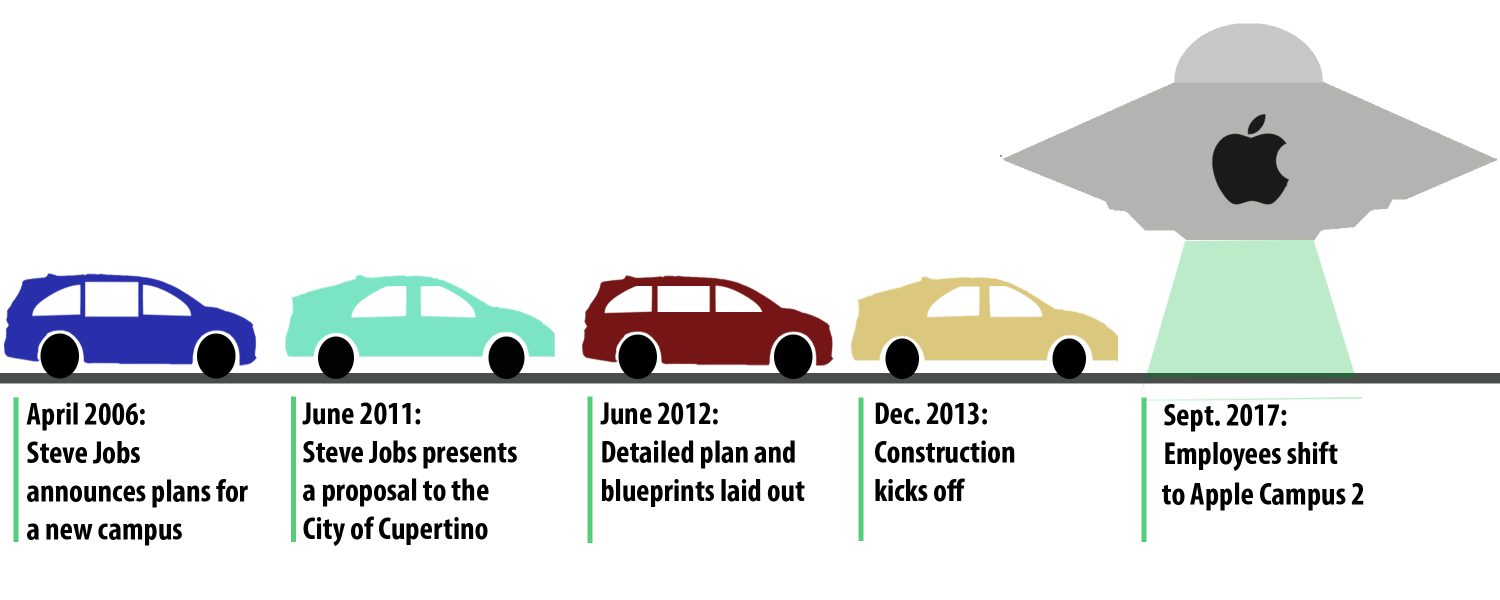Apple’s new campus construction disrupts local communities
September 28, 2017
In June 2011, Steve Jobs, the founder and former CEO of Apple Corporation made his last public appearance, presenting his vision for a new Apple Campus to the Cupertino City Council.
“I think we do have a shot at building the best office in the world,” said Jobs during his presentation.
Six years later, in April 2017, the 2.8 million square foot campus in Cupertino opened its doors. Yet as the construction of Apple’s new campus comes to an end, some of its likely negative impacts on local communities have become difficult to ignore.
Construction of Apple Park, known as “the spaceship” due to its circular design, began in October 2013 and finished in April 2017. Jobs envisioned a unique campus that would convey the innovative spirit of his expanding company, and the final result is truly one of a kind. Apple Park boasts the largest installment of curved glass in the world, contains a theater for corporate events, runs entirely on renewable energy and showcases a large outdoor quad. Inspired by Silicon Valley’s agricultural roots, 80 percent of the campus is green space. It is expected to hold more than 12,000 employees.
“When I heard about the opening of the spaceship, I was very excited because of its cool features, such as the fact that it is so environmentally friendly,” said junior Roopak Phatak. “However, I think congestion is going to become a growing concern for residents, especially during rush hour.”
Throughout the four years of the construction of Apple Park, residents nearby, especially those in the Birdland neighborhood of Sunnyvale, a block away from “the spaceship”, have experienced constant construction noise, dirt pollution and traffic. Although Apple appeased these residents during the construction period by offering them car wash coupons and ensuring that construction vehicles would not pass through their neighborhood, the company, as well as the City of Cupertino, should have taken more action to ensure that those residents were truly comfortable with the construction of the office space near them. As a company that prides itself on superior user experience, Apple should also put in the effort to ensure a great experience for its neighbors, now that the new campus has officially opened.
The city councils of Cupertino, Sunnyvale and San Jose should be open to receiving concerns from residents and working with each other and Apple to resolve them. Birdland residents felt that their voices were not heard when they made complaints about construction noise and traffic because they were not Cupertino residents. Moving into the future and knowing that the campus affects those in multiple cities, city governments should work together to address concerns related to population growth and traffic.
The new Apple campus brings both positive and negative effects to the community. Locals may expect an increasing number of major technology-related events held in their city, such as the recent reveal of the iPhone 8 on Sept. 12. The campus is estimated to bring an increase of $57 million in property tax, which can be used to fund schools, community spaces, roads, parks, libraries and fire and police departments. However, residents have experienced an increase in traffic since the commencement of the campus’ construction and predict that the traffic will continue to increase once more workers move into their offices in Apple Park.
“The roads by Wolfe were already small before any new construction, so an increase in people would definitely lead to more traffic,” said senior Olivia Wu. “There are ways to solve the problem though, like building new roads or having people bike or take shuttles to work.”
In addition to growing road congestion, many residents are also concerned about the rise of housing prices since the announcement of Apple Park. Realtors predict that many residents may sell their homes to Apple employees coming to Cupertino in order to move to less expensive communities, which would bring changes to the area’s demographic.
“A high-tech community is fabulous because it inspires growth, but it also runs the risk of having no stratification,” said U.S. government and economics teacher Jeffrey Bale. “Every community needs teachers, waiters and construction workers, but we may begin to see that these workers will not be able to afford living in the community they contribute to, just like we have seen in cities such as Manhattan.”
Bale has already witnessed the impact of growing house prices in the Lynbrook community: more and more teachers are unable to afford living near Lynbrook, causing them to have longer commutes and less time to stay involved in the Lynbrook community.
“At Lynbrook, we see that not many teachers live in the community,” said Bale. “That does not mean that they are not great professionals, but it does mean they are less likely to attend sporting events and be invested in the school community by supporting students after school. When teachers live further away, it is harder for them to build meaningful connections with Lynbrook families.”
While the opening of Apple Park brings excitement to its surrounding cities, local community officials must not ignore the problems that come with such a change: traffic, noise and overcrowding. If the City of Cupertino prioritizes the well-being of residents, those living near the campus will be able to experience the best of both worlds: a quiet residential neighborhood, as well as an industrial center booming with activity and innovation.




























































